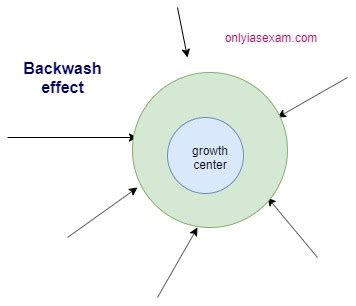Understanding the Backwash Effect
The backwash effect, a critical concept in human geography, refers to the negative consequences that migration and displacement can have on the sending region. Unlike the “spillover effect,” which emphasizes the positive impacts of migration on receiving areas, the backwash effect highlights the challenges faced by communities left behind.

Causes and Manifestations of the Backwash Effect
The backwash effect arises due to several factors, including:
- Brain Drain: Migration of skilled and educated individuals can deplete local human capital, hindering economic development and social progress.
- Labor Shortages: Outward migration can create labor shortages in sending regions, leading to wage distortions and economic slowdown.
- Political Instability: Mass migration can strain social and political systems, fostering instability and conflict.
- Environmental Degradation: Remittances sent by migrants can sometimes be used to exploit natural resources unsustainably.
Consequences for Sending Regions
The backwash effect has far-reaching consequences for sending regions, including:
- Economic Decline: Loss of skilled workers, labor shortages, and reduced investment can stifle economic growth.
- Social Disintegration: Migration can disrupt family structures, weaken social networks, and exacerbate social inequalities.
- Environmental Issues: Unsustainable land use practices can lead to deforestation, soil erosion, and water scarcity.
Case Studies and Data
- Mexico: The mass emigration of Mexicans to the United States has resulted in brain drain, labor shortages, and increased crime in some sending regions.
- India: The migration of skilled workers to developed countries has left India facing a shortage of qualified professionals, particularly in the fields of science, technology, and medicine.
- Bangladesh: Remittances sent by migrants have fueled unsustainable land use practices, such as shrimp farming, leading to deforestation and coastal degradation.
Mitigating the Backwash Effect
Recognizing the negative impacts of the backwash effect, governments and organizations are implementing strategies to mitigate its consequences:
- Skill Development Programs: Investing in education and training to build local skills and reduce reliance on foreign labor.
- Remittance Management: Encouraging responsible use of remittances for productive investments and sustainable development.
- Targeted Investment: Targeting investment in sending regions to create economic opportunities and reduce migration pressures.
- Political Stability: Promoting political stability and good governance to create an environment conducive to development and reduce the need for migration.
The “Back-to-the-Roots” Solution
An innovative approach to mitigating the backwash effect is the “back-to-the-roots” solution. This involves encouraging migrants to return to their home countries and contribute their skills and expertise to local development.
- Motivations: Nostalgia, a desire to give back, and economic opportunities in developing countries are driving migrants to return home.
- Benefits: Returnee migrants bring valuable skills, networks, and investment capital, enhancing local economies and reducing the brain drain.
Tables
| Table 1: Causes of the Backwash Effect | Table 2: Consequences of the Backwash Effect |
|---|---|
| Brain Drain | Economic Decline |
| Labor Shortages | Social Disintegration |
| Political Instability | Environmental Issues |
| Environmental Degradation | – |
| Table 3: Mitigating Strategies for the Backwash Effect | Table 4: Benefits of the “Back-to-the-Roots” Solution |
|---|---|
| Skill Development Programs | Enhanced Local Economies |
| Remittance Management | Reduced Brain Drain |
| Targeted Investment | Increased Investment Capital |
| Political Stability | Skilled Labor Force |
FAQs
Q: What is the backwash effect?
A: The negative consequences of migration and displacement on sending regions.
Q: What are the main causes of the backwash effect?
A: Brain drain, labor shortages, political instability, and environmental degradation.
Q: How does the backwash effect impact sending regions?
A: It can lead to economic decline, social disintegration, and environmental issues.
Q: What can be done to mitigate the backwash effect?
A: Invest in skill development, manage remittances, target investment, and promote political stability.
Q: What is the “back-to-the-roots” solution?
A: Encouraging migrants to return home and contribute to local development.
Q: What are the motivations for migrants to return home?
A: Nostalgia, a desire to give back, and economic opportunities.
Q: What are the benefits of the “back-to-the-roots” solution?
A: Enhanced local economies, reduced brain drain, increased investment capital, and a skilled labor force.
Conclusion
The backwash effect is a complex phenomenon with significant implications for migration patterns and regional development. By understanding the causes and consequences of the backwash effect, policymakers and organizations can develop strategies to mitigate its negative impacts and foster sustainable development in both sending and receiving regions.
